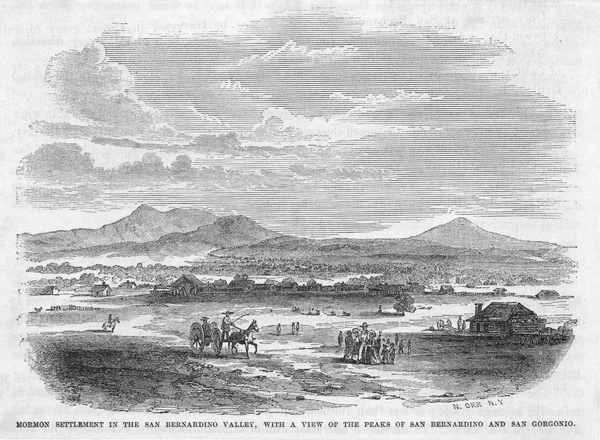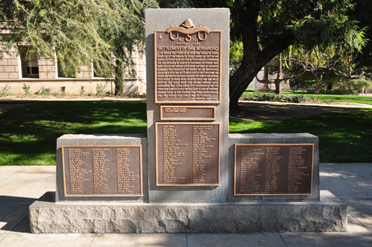Posts at San Bernardino
by Colonel Herbert M. Hart, USMCThe detailing of Company "C" of the Mormon Battalion to guard Cajon Pass in April 1847, had a more lasting effect than just cramping the Indian horse raids. When these men found that Brigham Young would permit them to establish a colony in California, the area below Cajon Pass came to mind.
Early in June 1851, a 150-wagon caravan of 500 Mormons reached a sycamore grove about 15 miles [south] of Cajon Pass, the site of the several camps which periodically were established to protect the pass. The Mormons stayed here while negotiating to buy the Rancho San Bernardino, 15 miles to the south. As soon as the $77,000 purchase was agreed upon, they started to build and plant although it was not until February 1852, that the final papers were registered.

News of an Indian skirmish alerted the newcomers to the dangers of the area. In the center of their new mile-square town of San Bernardino, the leaders set aside eight acres and fenced in a parallelogram. 300 feet wide by 720 feet. Twelve foot high walls protected three of the sides. The fourth side was a series of log buildings jammed close together. All exterior walls were loopholed and the gateways were indented to allow for crossfire.
Life for the first year at San Bernardino was centered at this enclosure, known variously as Fort San Bernardino or Mormon Stockade. Weapons and ammunition were lent to the occupants by the Army garrison at Rancho del Chino. Nightly guards were maintained and an elderly Negro, Uncle Grief, was put in charge of the alarm system: a battered horn which he was to blow in the event of an attack.
"Good industrious neighbors" is how the Los Angeles Star hospitably described the newcomers to Southern California. Ranger Horace Bell remembered his San Bernardino visits where "I was benefitted by my contact with these serious, rugged people. They set good examples for youth. There were no gamblers tolerated in San Bernardino, no rum sellers, no loud characters offering vice for sale. There were no drones there. Persistent industry, intensive husbandry were the impressive features of life there."
Within a year of their arrival, the Mormons were able to harvest their first crop. It was not long after, however, that they learned that the indefinite land boundaries made their titles somewhat hazy. Some of the properties also were claimed by outsiders. In 1856-57, one of these, Jerome Benson, was not satisfied with debating the matter. West of modem Colton, he mounted an old brass cannon inside of an earthworks, rammed the can non full of gunpowder and rocks, and challenged all comers to dislodge him.
The loyalties around "Fort Benson" were drawn more along property lines than religious. Mormons and Gentiles alike sided with or against each other, and Benson found he was not alone.
Then in October 1857, the word came back that took 55 per cent of San Bernardino's Mormons home to Salt Lake City. Brigham Young directed that the saints were to "return to Zion . . . regardless of condition or circumstance" and face the threat of an invasion by the United States Army. Many prosperous farms were literally given away, sometimes in exchange for little more than a camping outfit. In at least one case, $40 bought a four-room house complete with furnishings, buggy, cloak and sack of sugar.
With the realization that some of this money and much of the Mormon savings were going to buy arms and ammunition to fight the Army, there was some talk of blockading Cajon Pass, but nothing was done.
Soldiers arrived in San Bernardino on December 27, 1858, when Colonel William Hoffman's "Mojave Expedition" camped near the original Cajon guard post, a site they knew as "Camp at Martin's Ranch." When Hoffman moved to the Mojave River to locate a fort site, and incidentally do battle with the Indians, his main body remained at San Bernardino.
The camp was moved closer to the town and designated Camp Banning by the time that Hoffman returned on January 19, 1859. Spectacular as the success had been against the Mojaves, "the Indians refuse to allow any white men in their domain," wrote Sergeant Eugene Bander, "and have more than once made raids quite near us to steal cattle from the neighborhood."
Camp Banning became Camp Prentiss in May 1859, after Hoffman returned to the Mojave, established Fort Mojave, and decisively whipped the tribe. Until the fall, supplies for the Mojave were forwarded from Camp Prentiss.
Californians took slowly to the populace of San Bernardino and at the start of the Civil War were quick to believe rumors of disloyalty there. Major, later Major General, James H. Carleton made a civilian-clothes spying trip in 1861. He reported that the town consisted of 1,000 Mormons "of a man whose character is such that he could not be tolerated in Utah," and 500 others, mainly "a good many Jew merchants . . . adroit horse thieves and unprincipled desperate men," plus some "few respectable Americans." He recommended that two or more companies of troops be stationed at San Bernardino because "all but the few respectable Americans would set us at 'defiance tomorrow if they dared to do so."
Carleton's less-than-objective report was believed. On August 26, 1861, Major W. Scott Ketchum reported that he was at a "Camp near San Bernardino" with the first of four companies of the 4th Infantry, his sudden arrival thwarting a plot to ambush him en route.
Ketchum asked that he be reinforced by two dragoon companies to prevent a rumored plan to attack his camp. The decision for such an attack had been reached at several secret meetings of pro-Southerners, according to the latest rumors.
Ninety dragoons were secretly rushed to Ketchum. To mislead disloyal observers at Los Angeles, the dragoons left their tents in place and moved a Howitzer under cover in a wagon.
"The sudden and unexpected appearance of the dragoons had a very beneficial effect," Ketchum reported, especially on election day, September 4, 1861, when the "one or two displays of secession sentiments . . . were promptly checked by the show of a portion of the dragoons."
On October 20, Ketchum's 169 regular soldiers were relieved by three companies of California Cavalry, 272 men strong. Ketchum probably was pleased to leave San Bernardino-where his camp frequently was fired upon by snipers bidden in the surrounding bushes-and go to the battlefields of the East and ultimate rank as a major general of volunteers.
The California cavalrymen were horseless, a situation which gave Major Edward E. Eyre more worry than rebel activities. From the newly designed "Camp Carleton," Eyre wrote that his men had heard rumors that they were going to be turned into infantrymen.
"For God's sake do not leave me long with this only cause of danger banging over my head," Eyre appealed. "No exertions would be spared by myself, but should anything like a general mutiny occur, overboard I go, whether my fault or not." Eyre need not have worried; his men spent most of the war as cavalrymen in New Mexico and at San Elizario, Texas.
Troops stayed at San Bernardino until March 1862. They returned for five months in 1863, partly in response to reports that a leading secessionist recently released from prison was threatening to kill everyone responsible for his jailing. The previous year he had been arrested for hitting a soldier who protested a toast to "Jeff Davis' health."
Apparently all had cooled by October 1863, when the troopers were recalled and the newest San Bernardino post, Camp Morris, was closed. In the summer of 1865 an infantry company was sent to San Bernardino to check rumors of a secession plot, but by this time the war was over and the threat seemed anticlimactic.
Cajon Pass
Sycamore Grove
San Bernardino
Carleton
Hoffman
Mormon Battalion
Mormon Stockade
Martin's Ranch

Micheal Kindig photo
In March 1851 Charles C. Rich and Amasa M. Lyman, apostles of the Church of Jesus Christ of Latter-Day Saints, left Utah with 437 people "to establish a stronghold for the gathering of saints in California." Jefferson Hunt, David Seeley and Andrew Lytle were captains of organized companies. They purchased the Rancho 'de San Bernardino', selected a site for settlement, built a fort enclosing 100 homes and erected an adobe building for church and school. 1300 acres of grain were planted, grist and saw mills erected and roads made into nearby canyons. Local government was established, city incorporated and the population doubled. Before the call back to Utah by President Brigham Young in 1857, pioneers from Yerba Buena, England, and the Pacific joined the settlement.
~ San Bernardino County, California